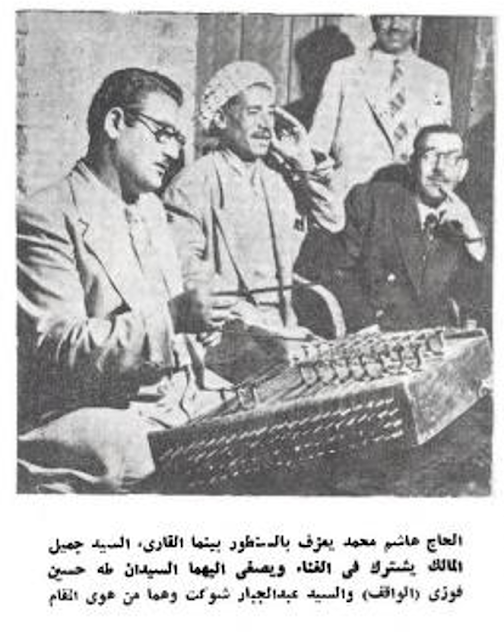The Poetic Content of the Iraqi Maqam
1. See al-Maqam al-'Iraqi by Hashim Muhammad al-Rajab, Maktabat al-Muthanna Publications, Baghdad, 1961, 40.
Classical Music of Iraq. "An intangible heritage of humanity" - UNESCO
المقام العراقي تراث غير ملموس للانسانية ~ اليونيسكو

.....................................................
Introduction:
Cairo Arab Music Congress 1932
Microtones: The Piano and Muhammad Al-Qubanshi
Melodies of Mulla Uthman al-Mawsili
.....................................................
مقالات مهمة
المقامات العراقية - عبد الوهاب بلال
المقام العراقي عرض وتلخيص - جلال الحنفي
الموسيقى الكلاسيكية العراقية - برنارد موسلي
المقامات العراقية - عبد الكريم العلاف
نظرة في المقامات العراقية - الأب نرسيس صائغيان
الغناء البغدادي واحوال المغنين - جلال الحنفي
المقام العراقي - دليل الجمهورية العراقية لسنة 1960
المقام العراقي موروث فني عريق مهدد- شهرزاد قاسم حسن
المقام العراقي خصوصية مهددة بالاندثار - الجزيرة
المفهوم الحقيقي للمقام العراقي- حسقيل قوجمان
الچالغي البغدادي - جلال الحنفي
مجالس الانس والطرب في بغداد - العلاف
الجالغي البغدادي دراسة نظرية - مهيمن الجزراوي
النغمة والحس النغمي في بغداد - جلال الحنفي
الاغاني الشعبية ومناسباتها - عبد الكريم العلاف
البستة العراقية وارتباطاتها الاجتماعية - جلال الحنفي
الموسيقى والمقامات في الموصل- محمد الجليلي
ذكريات عن المقام العراقي - حسقيل قوجمان
علاقة اليهود بالموسيقى العراقية - حسقيل قوجمان
الموال البغدادي الزهيري - عبد الكريم العلاف
الموال والغناء البغدادي في حياة الاشقياء
المقام العراقي بين الماضي والحاضر - يحيى ادريس
الشيخ جلال الحنفي والمقام العراقي - يحيى ادريس
موشحات دينية للملا عثمان الموصلي - زياد الشالجي
....................................................
قراء المقام العراقي
عبد الله المشهداني *
نمير ناظم *
رعد الاعظمي *
ابراهيم العبدلي *
يونس كني الموصلي *
اكرم حبيب *
حسين سعد *
كريم الخالدي *
محمد غانم التميمي *
عزيز الخياط *
ناظم شكر *
جبار ستار *
عامر الموصلي *
محمود فاضل القيسي *
عبد الحميد البناي *
حارث العبيدي *
عبد الجبار قلعه لي *
صلاح السراج *
مجيد حميد *
مربين صليوة *
غسان الطائي *
مجدي حسين *
رأفت نجم *
محمود زازا *
وسام العزاوي *
عبد المعز شاكر *
مقداد العبادي *
سعد الطائي *
ملا جمال النعيمي *
عز الدين الرفاعي *
سامر الاسمر *
انور ابو دراغ *
محمد الشامي *
نجاح عبد الغفور *
محمود الطائي *
بهاء الدين الزبيدي *
احمد جاسم *
مزهر العبيدي *
مصطفى سمير *
فاضل العگيلي *
مصطفى الزبيدي *
سعد البياتي *
علي هوبي *
سرمد ناظم *
مصعب عبد الكريم *
علي ضياء *
محمد وائل الراوي *
رامز الراوي *
مظفر الامير *
ملا منذر الاعظمي *
وليد الفلوجي *
عامر توفيق *
طارق القيسي *
مقداد محمد *
شريف جاسم *
عبد الرحيم الاعظمي *
عوني قدوري *
مائدة نزهت *
نجم عبود الرجب *
عبد المجيد الخشالي *
عاصم البغدادي *
محمد خليل الاعظمي *
علي مردان *
عبد الواحد كوزه چي *
ملا عبد الجبار الاعظمي *
الهام ملا عبود *
سيد اسماعيل الفحام *
ملا عبد الستار الطيار *
الحاج مرعي السامرائي *
يعقوب مراد العماري *
علي حسن داود العامري *
ملا بدر الاعظمي *
الحافظ عبدالله الراوي *
رشيد الفضلي *
توفيق الچلبي *
سعيد دخان *
عبد الخالق صالح *
جهاد الديو *
عباس القصام *
صالح الكويتي *
سليمة مراد *
اسماعيل عبادة القيسي *
مهدي العيسى *
ملا طه الشيخلي *
منيرة الهوزوز *
طاهر الشيخلي *
حسقيل معلم *
الست روتي *
جليلة ام سامي *
زينل صابونچي *
ملا عبد الله لوبياچي *
تتو المندلاوية *
ناحوم يونا *
مكي صالح العبيدي *
عباس بطاوي *
محمد علي خيوكة *
محمود نديم البناء *
عبد الرزاق القبانچي *
ملا محمد طوبال *
سيد امين الموصلي *
ابراهيم العزاوي *
حسين علي الصفو *
ملا طه عبد القادر كركوكلي *
ملا صابر عبد القادر كركوكلي *
علوان العيشة *
حميد التيلچي *
جاسم ابو النيص *
داود احمد زيدان *
شاؤول صالح گباي *
محمود قدوري النجار *
سلمان موشي *
قدوري العيشة *
انطون دايي بطرس *
الحاج جميل البغدادي *
شكر السيد محمود *
عبد الجبار گبوعي الاعظمي *
زينل الكردي الحمال *
الحاج مهدي الصباغ *
ساسون زعرور *
محمود القندرچي *
قدو جاسم الأندلي *
الاسطة محمود الخياط *
احمد حبيب الاعظمي *
السيد ولي العاني *
الحاج عبود الكاظمي *
قدوري القندرچي *
رزا حسين اغا *
سعودي مرزوگ *
الشيخ حميد المحتصر *
رحمين نفطار ناحوم *
حسن الشكرچي *
روبين رجوان *
مير القندرچي *
ابراهيم العمر *
خليل ابراهيم رباز *
سيد مهدي الرشدي *
عبد الوهاب شيخ الليل *
احمد علي الصفو *
سيد علي العاني *
احمد ويس الاعظمي *
اسرائيل ساسون روبين *
الحاج نعمان رضوان كركوكلي *
عبد الوهاب الافحج *
قوچ علي *
الحافظ بكر الاعظمي *
ملا سعيد الحلي *
حسقيل الياهو بيبي *
الحاج حمد جعفر النيار *
صالح ابو داميري *
سعيد الاعظمي *
احمد ابو الخواچي *
حسن البصير الشيخلي *
عبد اللطيف شيخ الليل *
حمد جاسم ابو حميد *
رحمة الله خليل شلتاغ *
حسقيل شاهين *
بكر التتنچي *
امين اغا ابن الحمامچية *
الحاج عبد الله كركوكلي *
علي الصفو *
حمه بيرة *
مال الله كركوكلي *
ماشالله المندلاوي *
ملا حسن البابوجچي *
ابراهيم نجيب *
يوسف نوري كركوكلي *
ملا عبد الرحمن ولي *
سيد سنطوري سليمان *
ملا سعدي الموصلي *
سيد علي الحكيم *
عثمان الخطيب الموصلي *
عبد الرحمن الموصلي *
موجيللا *
احمد ابن الخلفة *
ملا فرج الشيخلي *
This work is licensed under a Creative Commons Attribution-Noncommercial 3.0 Unported License.
اعداد وتحرير زياد الشالچي
بعض الحقوق محفوظة لاصحابها





Comments
Post a Comment